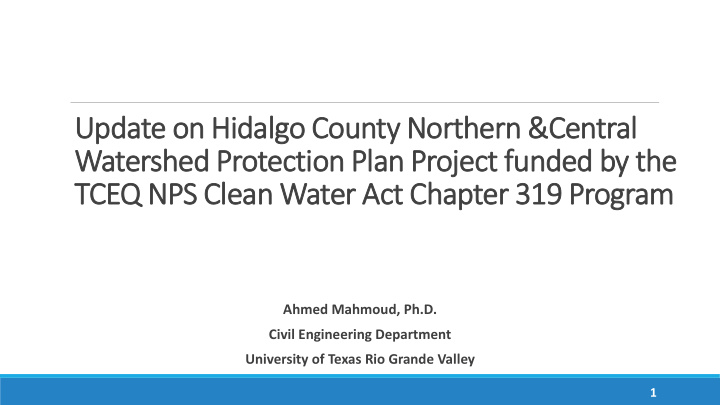



Update on Hidalgo County Northern &Central Watershed Protection Plan Project funded by the TCEQ NPS Clean Water Act Chapter 319 Program Ahmed Mahmoud, Ph.D. Civil Engineering Department University of Texas Rio Grande Valley 1
Laguna Madre is impaired for low DO and bacteria 2
Raymondville Drain: Collects stormwater runoff and return flows from subwatershed with predominant agriculture activity 3
Hidalgo/Willacy County Floodway • Carries urban stormwater runoff from central and northern Hidalgo County, and • Agricultural runoff from northeast Hidalgo County and Willacy County 4
USIBWC North Floodway • Built as a system of floodways in the 1930s • From Penitas, Texas to the Gulf of Mexico • In 1967, Hurricane Beulah (27 inches/36 hours – 136 mile/hr), damages ($234.6 million). • From 1968 to 1977, $29 million was invested in project improvements. 5
USIBWC North Floodway • Constantly drains WWTP effluent and • During large storm events, collect excess runoff from urbanized areas of Hidalgo County and agriculture land in Cameron and Willacy County. 6
Background • The Raymondville Drain and the Hidalgo/Willacy Main, the IBWC pilot channel (IBWC North Floodway) flow into the Lower Laguna Madre which is impaired for low DO and bacteria. • The three floodways collects stormwater runoff and agriculture runoff activity (Non-point source Pollution). • There is a lack of water quality data collection within the target region and limited data has been collected 7
Water Quality Monitoring station 8
Flow Monitoring station 9
Project Description • The major sub-watersheds must be characterized to identify potential causes and sources of impairments. • This project will identify existing data and identify data gaps for characterization as well as identify a path forward by selecting an analytical method for estimating pollutant loads 10
Watershed Protection Plans Meets the Nine Elements listed in EPA’s Handbook for Developing Watershed Plans Restoration Protection 11
EPA’s 9 -Elements A- Identify causes and sources of pollution B - Estimate pollutant loading into the watershed and the expected load reductions C - Describe management measures that will achieve load reductions and targeted critical areas D - Estimate amounts of technical and financial assistance and the relevant authorities needed to implement the plan E - Develop an information/education component F - Develop a project schedule G - Describe the interim, measurable milestones H - Identify indicators to measure progress I - Develop a monitoring component 12
Project Goals Goal Measure of Success Partial development of Element A and Completion of Watershed Characterization initiation of Element E of EPA’s Nine – Data Evaluation Report and approval from TCEQ PM. Elements for WBPs found in the Handbook for Developing Watershed Plans to Restore and Protect our Waters. Engage stakeholders to provide input for Formation of Stakeholders workgroups. the development of a Strategic Plan moving forward based on information List of next steps for watershed-based presented from the Watershed planning in the Partnership Coordination Characterization. Report. 13
Task 1: Project Administration • Quarterly Progress Report (QPRs) • Coordination meeting with EPA • Annual Report article and pictures • Contract and Annual Budget updates 14
Task 2: Quality Assurance • QAPP Planning Meeting notes • Draft and Final QAPP • QAPP Annual Reviews and Revisions • Draft and Final QAPP Amendments 15
Task 3: Watershed Characterization – Data Evaluation and Analysis • Summary of existing data and information • Cyberinfrastructure establishment and database development • Interim Existing Data and Information Analysis Report • Draft and Final Watershed Characterization and Next Steps Report 16
Task 4: Partnership Coordination • Develop PPP (Public Participation Plan) • Documentation of key stakeholder meetings, including agendas, presentations, and sign in sheets, minimum of three per quarter • Draft and Final Partnership Coordination Report 17
Public Participation Plan NCLRGV Steering Committee and Stakeholders LRGVDC Water US EPA TCEQ UTRGV Management Advisory Group Hidalgo/Willacy Raymondville Drain USIBWC Pilot Channel/Floodway Floodway SC Watershed SC Watershed SC Urban WG Urban and Non-Urban WG Urban WG Habitat WG Non-Urban WG Non-Urban WG Outreach and Education WG Outreach and Education WG Outreach and Education WG Technical Advisory WG Technical Advisory WG Technical Advisory WG 18
Willacy County Hidalgo Hidalgo County County Cameron Alamo County 19
Public Participation Plan 20
Steering Committee Meetings 21
Task 5: Final Report • Draft Final Report • Address TCEQ/EPA comments • Final Report 22
Project Website https://rgvstormwater.org/tceq-319-characterization-of-northern-and-central-rio-grande-valley-watersheds/ 23
Project Website https://rgvstormwater.org/tceq-319-characterization-of-northern-and-central-rio-grande-valley-watersheds/ 24
1- Raymondville Drain Watershed Protection Plan - Includes region above the Hidalgo/Willacy Floodway northern watershed boundary to the northern LRGV County limits, and from the Starr County border to the Laguna Madre. 2- Hidalgo/Willacy Floodway Watershed Protection Plan - Includes region above the Arroyo Colorado to the south watershed boundary of the Raymondville Drain, and from the Starr County border to the Laguna Madre 3- USIBWC Pilot Channel/Floodway Watershed Protection Plan - From the Rio Grande River region, including regions not included in the Arroyo watershed, along the Rio Grande River continuing north and then east to the Laguna Madre. 25
Questions? Texas Commission on Environmental Quality (TCEQ) Clean Water Act (CWA) Section 319(h) Nonpoint Source (NPS) Grant Program through UTRGV TCEQ Project Manager : Tim Cawthon PI : Andy Ernest, Ph.D., P.E., BCEE, D. WRE Co-PI: Javier Guerrero, M.S., E.I.T Watershed Coordinator : Ahmed Mahmoud, Ph.D. 26
Recommend
More recommend